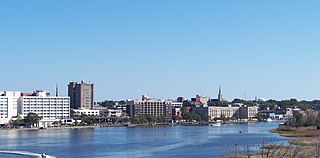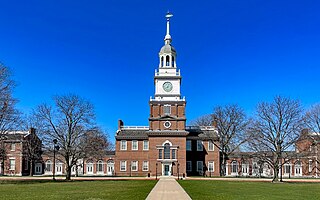
The Cape Cod National Seashore (CCNS) encompasses 43,607 acres on Cape Cod, in Massachusetts. CCNS was created on August 7, 1961, by President John F. Kennedy, when he signed a bill enacting the legislation he first co-sponsored as a Senator a few years prior. It includes ponds, woods and beachfront of the Atlantic coastal pine barrens ecoregion. The CCNS includes nearly 40 miles (64 km) of seashore along the Atlantic-facing eastern shore of Cape Cod, in the towns of Provincetown, Truro, Wellfleet, Eastham, Orleans and Chatham. It is administered by the National Park Service.

Wilmington is a port city in New Hanover County, in southeastern North Carolina, United States; it is also the county seat. With a population of 115,451, it is also the eighth-most populous city in the state and the principal city of the Wilmington, NC, Metropolitan Statistical Area, which includes New Hanover, Brunswick, and Pender counties. As of 2023, its metropolitan statistical area had an estimated population of 467,337.

The Henry Ford is a history museum complex in Dearborn, Michigan, United States, within Metro Detroit. The museum collection contains the presidential limousine of John F. Kennedy, Abraham Lincoln's chair from Ford's Theatre, Thomas Edison's laboratory, the Wright Brothers' bicycle shop, the Rosa Parks bus, and many other historical exhibits. It is the largest indoor–outdoor museum complex in the United States and is visited by over 1.7 million people each year. It was listed on the National Register of Historic Places in 1969 as Greenfield Village and Henry Ford Museum and designated a National Historic Landmark in 1981 as "Edison Institute".

Fort Fisher was a Confederate fort during the American Civil War. It protected the vital trading routes of the port at Wilmington, North Carolina, from 1861 until its capture by the Union in 1865. The fort was located on one of Cape Fear River's two outlets to the Atlantic Ocean on what was then known as Federal Point or Confederate Point and today is known as Pleasure Island. The strength of Fort Fisher led to its being called the Southern Gibraltar and the "Malakoff Tower of the South". The battle of Fort Fisher was the most decisive battle of the Civil War fought in North Carolina.
Graveyard of the Atlantic is a nickname for the treacherous waters and area of numerous shipwrecks off the Outer Banks of North Carolina, United States, which are due to the coast's shifting sands and inlets. To a lesser degree, this nickname has also been applied to Sable Island off of Nova Scotia, Canada, as well as the waters off Cape Cod, Massachusetts, United States.

Nauset Light, officially Nauset Beach Light, is a restored lighthouse on the Cape Cod National Seashore near Eastham, Massachusetts, erected in 1923 using the 1877 tower that was moved here from the Chatham Light. It is listed on the National Register of Historic Places. The tower is a cast-iron plate shell lined with brick and stands 48 feet (15 m) high. The adjacent oil house is made of brick and has also been restored. Fully automated, the beacon is a private aid to navigation. Tours of the tower and oil house are available in summer from the Nauset Light Preservation Society which operates, maintains and interprets the site. The tower is located adjacent to Nauset Light Beach.

Saybrook Breakwater Lighthouse is a sparkplug lighthouse in Connecticut, United States, at Fenwick Point at the mouth of the Connecticut River near Old Saybrook, Connecticut. It is featured on the state's "Preserve the Sound" license plates.

Race Point Light is a historic lighthouse on Cape Cod, in Provincetown, Massachusetts; it is on the National Register of Historic Places. The original tower, first illuminated in 1816, was replaced in 1876 with the current 45-foot tall iron-plated tower and a new keeper's dwelling. The American Lighthouse Foundation operates the property and rents out two buildings for overnight stays. The actual light is maintained by the Coast Guard. The site is reached by walking about 45 minutes over sand; with a National Park Service Oversand Permit, a four-wheel-drive vehicle can be used.

College Hill is a neighborhood in the west central section of the United States city of Greensboro, North Carolina. College Hill was Greensboro's first neighborhood.

Long Point Light Station is a historic lighthouse at the northeast tip of Long Point in Provincetown, Massachusetts. As a navigational aid, it marks the southwest edge of the entrance to Provincetown Harbor. The United States Coast Guard Light List describes it simply as a "white square tower". The light it casts is green, occulting every 4 seconds, and, at a focal height of 35.5 feet (10.8 m) above mean sea level, has a visible range of 8 nautical miles. When the weather affords low-visibility, one can hear the station's fog horn – sounding a single blast for two seconds, and repeating every 15 seconds – as it seems to call out for its nearly-identical closest neighbor, the Wood End Light.

The Drake Park Neighborhood Historic District is located adjacent to Drake Park near the historic downtown area in Bend, Oregon, United States. Because of the unique and varied architecture in the Drake Park neighborhood and its close association with the early development of the city of Bend, the area was listed on the National Register of Historic Places in 2005.

The Three Sisters of Nauset are a trio of historic lighthouses off Cable Road in Eastham, Massachusetts. The original three brick towers fell into the sea due to erosion in 1890 and were replaced with wooden towers on brick foundations in 1892. The Sisters were decommissioned in 1911 but one of them, the Beacon, was moved back from the shoreline and attached to the keeper's house. It continued to operate but was replaced by a new steel tower, the Nauset Light, in 1923.

Rosedale Park is a historic district located in Detroit, Michigan. It is roughly bounded by Lyndon, Outer Drive, Grand River Avenue, Southfield Freeway, Glastonbury Avenue, Lyndon Street and Westwood Drive. It was listed on the National Register of Historic Places in 2006. The Rosedale Park district has the largest number of individual properties of any district nominated to the National Register of Historic Places in Michigan, with 1533.

The Boyd Avenue Historic District is a residential district comprising 80 houses in Martinsburg, West Virginia. The district includes the circa 1776 Aspen Hall and the associated Mendenhall's Fort of circa 1756. The district extends along Boyd Avenue 1,500 feet (460 m) from West Race Street to Aspen Hall. The older section of the street is a single 40-foot (12 m) right-of-way, while the newer portion is boulevarded, with a grassed median between two separate roads. The older section is significant from about 1888 to 1914, while the newer portion is significant from 1914 to the 1950s.

The Hi-Mount Historic District is a historic neighborhood located two miles north of downtown Raleigh, North Carolina, United States. The eleven-block district, developed between 1938 and 1951, is one of the city's best-preserved twentieth century speculative neighborhoods. The district encompasses 168 contributing buildings and 1 contributing site. Most of Hi-Mount's homes are Minimal Traditional in style, followed by Cape Cod and Ranch homes with sparse detailing. A small number of developers were involved with the district and the district also benefited from government housing financing programs such as the Federal Housing Administration and the Veteran's Administration, resulting in architectural consistency throughout the neighborhood.

Alton Lennon Federal Building and Courthouse, also known as the Customs House, is a historic Federal building and courthouse located at Wilmington, New Hanover County, North Carolina. It was designed by the Office of the Supervising Architect under James A. Wetmore and built between 1916 and 1919. It is an imposing three-story, Classical Revival style light sandstone building. It consists of a central mass with balanced projecting wings having engaged pedimented porticos. The design of the front facade of the earlier 1840s customs house is incorporated into the projecting wings to the cast iron details. The building measures 332 feet by 113 feet. The building was named for U.S. Congressman and Senator Alton Lennon (1906-1986) in 1976. It was used as the outside of the courthouse on seasons 7-9 of Andy Griffith's TV series Matlock on ABC.

The Wilmington Historic District is a national historic district located at Wilmington, New Hanover County, North Carolina. The district encompasses 875 contributing buildings 38 contributing sites, and 3 contributing structures in the historic core and surrounding residential sections of Wilmington. The district developed after Wilmington was laid out in 1737, and includes notable examples of Queen Anne and Bungalow/American Craftsman style architecture. Located in the district are the separately listed City Hall/Thalian Hall and Alton Lennon Federal Building and Courthouse. Other notable buildings include:

The Springwells Park Historic District is a historic residential neighborhood located in Dearborn, Michigan and bounded by Rotunda Drive, the Michigan Central Railroad line, and Greenfield and Eastham Roads. The district was listed on the National Register of Historic Places in 2015.

Eagar Townsite Historic District is a section of the town of Eagar, Arizona which has been designated a National Historic Place. Sitting on roughly 54 acres, the site contains 37 structures, 21 of which have historical significance. The period of significance is from 1886, the year the townsite was founded, through 1942, which represents the significant period of development of the town. The site was added to the Register on July 23, 1993.





























